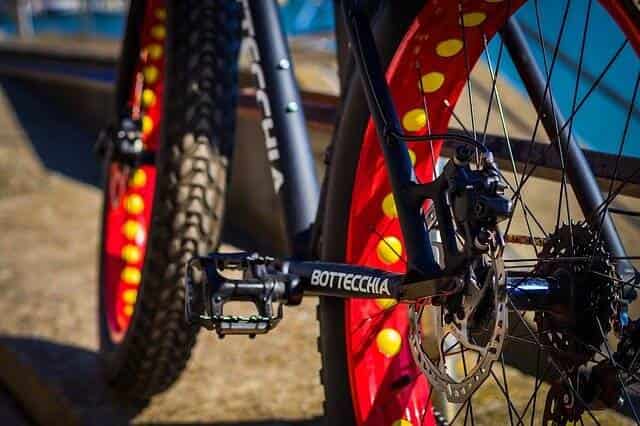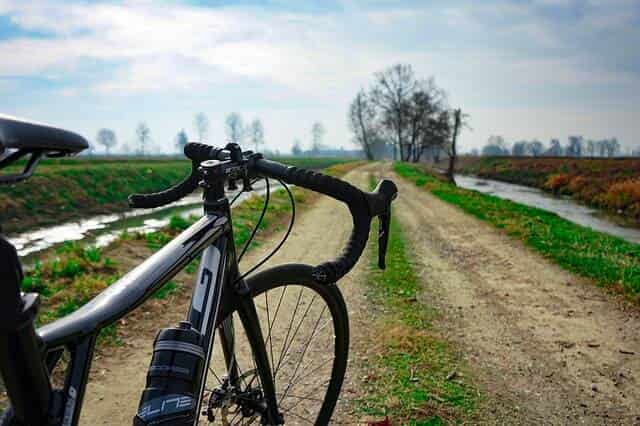A penny-farthing is as different from a modern bike, as a gravel bike is different from a road bike. The base concept is the same, but then take another look and see the differences.
The wheels, pedals, brakes, and obviouYou will notice the tires first ify, purpose.
If you put the two bikthe tires first. It will appear it’s the only thing you need to buy to turn your old bike into a multitasking machine. However, as you may have suspected, things are not that simple.
So, today we will go over both road and gravel bikes their purpose and their major differences. Hopefully, by the end, you will have a better understanding of which one should you buy and become an informed consumer.
Gravel bikes are used by professional cyclists who love to ride on high terrains. It is a bike meant for an adventure. That’s why it’s also called adventure bikes used by people who love cycling and are quite regular.
The other type of bike is the road bike, and they are used for competitive cycling; their significance is opposite to that of gravel bikes. Road bikes can go really fast on paved roads but aren’t versatile.
Road Bikes: What are They Good for?
A road bike is a term applied to any type of bicycle you can ride at high speed on a paved road. The most recognizable visual characteristic are the handlebars curving downwards.
The drop-bar shape allows the rider to take on the bent-forward riding posture, which makes them more aerodynamic. This means that road bikes are ideal for racing.
This bike is also suitable for fitness and training, as well as commuting and touring. For most riders, a road bike is a great multitasker they can rely on for different purposes. But, there are downsides.
First, the weather. The bike doesn’t pair well with rain, especially in a city. What makes it great for racing becomes a liability when commuting in the rain.
It also takes a while to get used to. Compared to a standard bike, it’s not as comfortable and stable. It also requires more muscle strength and durability from the rider. Definitely not suitable for a beginner.
Gravel Bikes: What are They Good for?
A gravel bike is a bicycle equivalent to an all-terrain vehicle. At first sight, it resembles a standard road bike, especially since it also features drop-bar handlebars.
However, it also has other modifications that make it suitable for rougher terrains.
Though a gravel bike was designed to ride over, well, gravel, it’s also usable on a paved road and asphalt. This doesn’t make this bike ideal for bike-packing but on any ride over variable terrain.
In terms of versatility, it beats the road bike, hands down. But, that versatility and durability come with downsides. The first is the weight, and the second is speed.
These bikes are by default heavier, which also makes them slower. And, as you may have guessed it by now, they require even more muscle strength and stamina, especially if you are trying to get top speed.
Finally, there’s the price. Gravel bikes are always more expensive than classic, road, and mountain bikes.
Difference Between Gravel Bike And Road bike
Geometry
A road bike has to deliver on speed, while a gravel bike has to deliver on stability. This difference has the biggest impact on their geometry.
A road bike has to be more responsive, so the ride is usually longer and lower.
This helps flatten your beg and bend your hips more. There are additional details based on the purpose of the bike, but you’ll often see either a setup that lowers your center of gravity or one that promotes an upright riding position.
The former you’ll find on racing bikes, while the latter is a staple on bikes designed for longer rides.
Gravel bikes almost always prefer the upward riding position, though you can also find racing gravel bikes as well. This is why they have a longer wheelbase and shorter reach.
They often also feature higher seats, which is supposed to absorb the shock from riding over rough terrain.
Frame Material
Gravel bikes are subject to more vibration while riding over rough terrain. As such, manufacturers usually use steel for the frame. Aluminum and carbon fiber are also common, but it’s highly recommended to go for steel if you are planning on pushing the bike’s limits.
The steel will offer durability, shock absorption, and longevity.
Carbon is a better option if you are looking for speed. The latter is also often more affordable since it’s easier and cheaper for manufacturers to produce long tubes from carbon.
Aluminum is slightly heavier than carbon but provides the same degree of stiffness, but it’s prone to long-term fatigue and doesn’t have the longevity of the other two materials.
The same three materials are used to produce road bikes as well, but we’ll add titanium to the list as well.
Carbon and titanium are usually the best options for road bikes, with carbon being a better choice for racing bikes, and titanium working best for endurance models.

Brakes
Gravel bikes exclusively have disc breaks. They outperform rim breaks in every way on rough terrain and the rain.
When shopping, you’ll have a choice between mechanical and hydraulic disc brakes Hydraulic brakes are better than mechanical ones, but they are more expensive and require more maintenance.
Road bikes also come with disc breaks these days since both the riders and manufacturers prefer them. However, you can still find models with rim breaks, especially budget-friendly models.
It’s fine to pick a road bike with rim breaks, especially if you don’t plan on riding over uneven terrain and in rain.
Rim breaks may be even beneficial in some cases since they are slightly more efficient at breaking the momentum at high speeds.
Wheel and tires
Road bikes usually have a short wheelbase and steeper angles. This allows for better control and nimble handling. On the other hand, gravel bikes have a longer wheelbase that adds to the stability.
It also slows down handling for navigating obstacles and loose descents.
The difference between tires stands out the most visually. But besides being bulkier, the gravel bike tires have more texture. They have thread and knobs that can dig into the dirt and other soft surfaces.
The road bike tires are more or less smooth. They don’t have to add much to the grip, so they have minimal texture if any at all. And in the same fashion, there is a vast difference between ideal tire pressure.
Gravel bike tires should be between 15 and 50 PSI, while road bike tires should be between 80 and 130 PSI. The higher the tire pressure, the more speed. The lower the pressure, the more stability.
Suspension
Road bikes don’t need great suspension, and they often don’t have any. They are designed to get from point to point B fast, and suspension only adds to the weight, which in turn decreases speed.
If you find suspension listed on the specs of a road bike, that bike is built for endurance riding. And even in some cases, it won’t compare to the setup you had on that one with training wheels you had as a kid.
Gravel bikes, on the other hand, often have suspension. In most cases, 20mm of terrain absorption is ideal. Having at least a front suspension smooths out high-frequency vibrations, and it improves comfort during long rides.
Keep in mind that there is no industry standard and that this part is left out for the rider’s preference. It’s easy enough to find models without suspension if you don’t want it.

Durability
Gravel bikes are more durable than road bikes. Just by their nature and purpose, they are built to withstand greater challenges and harsher environments.
They are usually made from heavier materials to be more robust. A gravel bike can’t outrun a road bike in terms of speed, but it will do so in terms of longevity.
Gravel bikes also fare better as commuter bikes, both in cities and rural areas.
Their lifespan is longer overall, plus tire replacement and maintenance costs are lower. And in case of an accident, you have better chances of bringing the bike home whole.
Gearing
Both will have 1x and 2x drivetrains. Road bikes tend to have two front chainrings, as the jumps between gears are smaller. This makes it easier to find a more comfortable rhythm at high speed.
The 2x setup is preferred by most road bike riders.
The gravel bikes tend to lean more toward 1X, because of their need for stability. The lower gears are also an advantage on steeper roads.
Road bikes also often come with more gears than gravel bikes. You’ll see this most often in models designed for racing.
Pedals
Gravel bikes almost never have clip-in pedals. Riding a gravel bike often requires you to put down for stability, so a clip-in pedal would become a nuisance very soon.
Also, clipless pedals give you better power transfer while you effectively pedal through the whole pedal stroke. They also provide a more secure platform over uneven and challenging terrain.
Road bikes can use both clip-in and clipless pedals. The main difference is in the purpose of the bike.
The clip-in pedals are better suited to quick races, where a rider can’t afford to lose a single second on realigning the foot when it slips.
The clipless pedals will work in almost every other situation, especially during long-distance rides and city commutes where the rider is expected to step off for balance.

Why Are Gravel Bikes So Expensive?
Gravel bikes are heavier, and the material used in them is very expensive; that’s why gravel bikes are very expensive.
Other than that, gravel bikes can be used as a road bike, and for the original purpose, it serves to ride on high altitudes. The spare parts of gravel bikes come at a high rate, and only superior quality material is used in it so that the rider can ride more efficiently.
Also, gravel bikes’ demand is more than road bikes because gravel bikes are also used for stunts and adventure sports. Gravel bikes come in the luxury category, and road bikes have a basic touch.
Gravel bikes have an extra accessory that is not found in hydraulics in road bikes, and this individual spare part is very expensive. Without hydraulics, the gravel bikes won’t be able to function at their best.
The rolling efficiency of gravel bikes is fairly more, and we can ride these bikes on any surface, be it tarmac or forest roads. In short, gravel bikes have many features. That’s why it’s very expensive.
Should You Use Gravel or a Road bike?
Both of these bikes are good at their place because they effectively serve the purpose they are made. There is no right answer to this. It solely depends on the surface on which you want to ride the bike.
A road bike is best for rough surfaces of roads, and gravel bikes are best for steep terrain that of hills.
But if we keep these purposes aside and judge based on the quality of material used and judge based on which one will be a better purchase, it will be a gravel bike.
Gravel bike uses the best material, and since it is used for difficult roads, a gravel bike can be used as a road bike, so when it comes to choosing between the two, you should use a gravel bike anytime.
A road bike is useful for professional cyclists who participate in competitions and need to practice beforehand. This is because road bikes are made so that they are speed efficient and focus on high endurance. Road bikes’ design focuses on the high speed that’s the bike is very lightweight.
Terrain Type Vs Best Bike | Road bike | Gravel bike |
Rough Roads | ❌ | ✔️ |
Nice Paved Roads | ✔️ | ✔️ |
Wet And Dusty | ✔️ | ✔️ |
Wet And Smooth | ✔️ | ❌ |
Difficult Terrain | ❌ | ✔️ |
Trail Tracks | ❌ | ✔️ |
Can You Use a Gravel bike as a Road bike?
Yes, a gravel bike can serve the purpose of being a road bike too. A gravel bike is designed to make it suitable to ride on difficult altitudes and terrains.
If it can achieve a good speed on a high altitude, it will offer a good speed if you ride it on the road, it will be even faster than a road bike itself.
Since the brakes, wheels, and tires of a gravel bike are made for doing adventure sports and riding on difficult terrains, a gravel bike will offer more stability, grip, and efficiency if ridden in place of a road bike.
So if you wish to buy a bike that you can ride on high terrains and the roads with a good speed and excellent quality material, you must go for a road bike because of its outstanding features.
It serves both purposes in a nutshell, so why not choose a gravel bike over a road bike.
The brakes used in gravel bikes will give a good grip to help you ride on slippery roads. Investment in a gravel bike will prove to be more beneficial.
Conclusion
So while selecting a bike for yourself, you should have prior knowledge about the type of bikes, what purpose it serves, and differences between them.
By reading all the facts about gravel bikes and road bikes by now, you must be aware of the difference each of them is used for distinct purposes, so while choosing a bike, pay attention to the purpose for which you need a bike.
Are you riding the bike on rough paved roads? Do you need good speed? Then a road bike will be a good choice for you. Are you riding on rough, steep terrain and looking for something with less weight and comfort? Then a gravel bike will be a feasible alternative for you.
Also Read,
Fixie vs Road Bike: Are Fixies Faster Than Road Bikes?
Mountain Bike vs Hybrid: What Are The Differences?









Leave a Reply